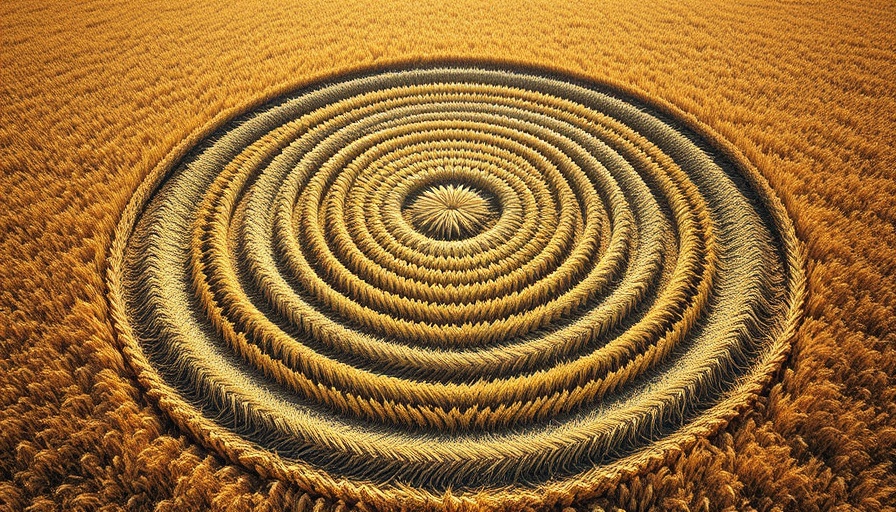
The Truth Behind Crop Circles: More Than Meets the Eye
Crop circles—those striking patterns that seem to emerge overnight in fields—have captured the imagination of many. Often linked to extraterrestrial visitors, their true origins are surprisingly mundane. While the phenomenon peeks interest from farmers to enthusiasts, understanding crop circles can give homeowners a fresh perspective on agriculture and our connection to the land.
A Historical Look at Crop Circles
Although sightings of unusual field patterns date back centuries, modern crop circles gained popularity in the late 20th century, specifically in the 1970s. During this time in England, communities began noticing these mysterious geometric designs appearing overnight in crops. Conspiracy theories abounded, associating these patterns with UFO landings. However, by the 1990s, two Englishmen revealed their hand in creating many of these fanciful patterns, taking credit as artists rather than aliens. This admission helped demystify the phenomenon but didn't erase the aura of curiosity surrounding crop circles.
Understanding the Mechanics: What Really Causes Crop Circles?
Given their strange shapes, it’s easy to think crop circles are works of otherworldly beings. In reality, many patterns result from various agricultural practices. For instance, when farmers harvest grass or corn for silage, they often leave patches behind, leading to geometric patterns in fields. Farmers must balance moisture levels, prompting them to cut sections from wetter fields while leaving others intact.
Additionally, the implementation of tile lines underneath agricultural fields can contribute to unique crop appearances. These perforated pipes are strategically installed to manage excess water, leading to enhanced growth over certain areas, which can foster unnatural-looking shapes under specific conditions.
Nature's Role: Lightning, Wind, and Weather
Mother Nature is another contributor to crop circles—or at least some unusual crop patterns. Lightning strikes can create sections of flattened crops. When a bolt hits, it can scorch the plants in that spot. Furthermore, windy weather can topple crops, creating seemingly random designs that provoke speculation.
As they’ve become more known, crop circles have evolved beyond mere agricultural phenomena into canvases for artistic expression. Both amateur and professional artists have taken to crafting elaborate patterns that often dazzle from the sky. These creations may call for precision work, sparking conversations about art, land use, and community engagement. They also encourage locals to contemplate the connections they share with both the land and its diverse uses.
Why Understanding Crop Circles Matters to Homeowners
For homeowners, especially those in MidSouth communities, grasping the concept of crop circles touches on broader themes of sustainability and appreciation for local agriculture. Understanding crop patterns can foster deeper respect for farming practices while promoting the idea of fresh, local produce. In a world where urbanization threatens traditional farming, discussions about the importance of agriculture in local food systems can inspire individuals to support local farmers and sustainable practices.
Connect with Your Local Environment: Benefits of Sustainable Living
Engaging with the agricultural world—whether understanding crop circles or supporting local farms—can significantly impact well-being. Sustainable living promotes healthier eating habits and encourages stewardship of the climate. As homeowners delve deeper into their local ecosystem, they build a stronger connection to the environment and potentially discover new avenues for community involvement.
Take Action: Explore the Beauty Surrounding Us
Understanding the origins and meanings behind crop circles provides not just entertainment but also a perspective that enriches homeowners' lives. It can inspire community involvement and local support for agricultural practices that benefit both health and the environment. If you find beauty in these intricate patterns, consider reaching out to local farmers, visiting your local farmer’s market, or even exploring ways to support sustainable agriculture initiatives. Every small action counts towards fostering a healthier community.
Exploring the landscape around your home can lead to a deeper appreciation of where our food comes from, reducing our ecological footprint while cultivating a personal connection with nature. Your journey into the local agricultural world may just be a passion waiting to bloom.
 Add Row
Add Row  Add
Add 



Write A Comment